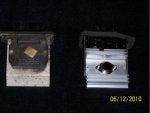Not a resistor pack
Here are the pics and a drawing showing what the resistance readings should be. In case the drawing isn't clear, I had to enlarge the alignment hole in the new resistor pack because it wasn't exactly in the same place as the old one. It was off by about 1/4 inch. I did this with a Dremel tool. The plugs were reversed on the new pack, but it didn't cause any problem hooking it up.
Hope this helps! I'm also going to post these pics on another thread about the same topic.
What is the link to that other thread?
NOT a resistor pack. I think there is some confusion about what is pictured. I had the same failure on my wife's 1996 Grand Cherokee a couple of years back. Here is what I learned from the Service Manual and my local Jeep parts department...
Two different parts exist that fit in the same heater housing socket.
1. Grand Cherokee with ATC (Automatic Temperature Control) has the device pictured with two plug wells. It is not a resistor pack, but is in fact a power transistor (1996 and prior), known in the Jeep GC 1996 Service Manual as the Blower Motor Power Module. The power transistor responds to the ATC to create varying output, giving infinitely variable speed control. The power transistor generates heat, although nothing like a resistor pack, and the big aluminum heat sink protrudes into the air stream cooling it. At full blower speed maximum heat is generated, so when HIGH is selected there is a relay wired in parallel with the power transistor that closes to deliver full battery voltage to the blower mostly bypassing the power transistor thus keeping it cool.
Non-ATC vehicles have a true resistor pack, if I remember correctly, the parts counter man said these have only one plug well instead of two.
2. Three things can kill the blower speed control power transistor. In our car, which is parked outside:
A) Mice built a nest over the heat sink preventing it from being cooled by the passing air stream. Any buildup of debris covering the heat sink will lead to overheating of the part and eventual failure.
B) The High Speed Relay contacts become tarnished and non-conductive or the relay fails, causing all the blower current to pass through the power transistor stressing it.
C) The back of the power transistor's heat sink was coated at the factory with a thermal conductive paste, the same sort of product applied to computer CPU chips to allow them to shed heat. The thermal conductive paste degrades or dissolves over time, causing the power transistor to get hot as it can shed heat efficiently to the aluminum heat sink.
In my wife's 1996 GC, I suspect all three faults were in play. After pulling the fuse to get the fan to stop, on removing the power transistor plate from the heater housing, a mountain of leaf litter, maple seeds, mouse poop, grass, etc. came spilling out. Our power transistor's heat sink was completely buried. After buying a replacement factory speed controller, my Jeep parts guy cautioned me about the HIGH speed relay failing or having resistance, leading to the failure of the speed controller; on checking ours, it was tarnished and had 2-3 ohms across the contacts. When I did a postmortem on the old blower speed controller, there was little of the thermal conductive compound left between the big black encase Delco power transistor chip and the aluminum heat sink. At the time I assumed car wash soapy water had been repeatedly been drawn into the heater passage and had partially washed away the thermal compound.
If your speed controller is still good, it might be a good idea to pull it to clean away any debris, then check to make sure there is a thick coating of thermal compound remaining. Arctic Silver (on Amazon) is a good product to re-coat the heat sink/chip if needed.

















